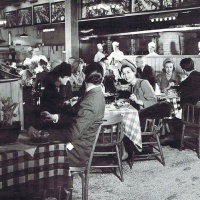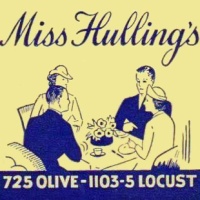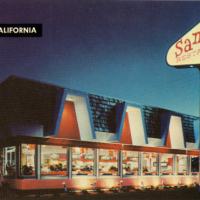At a self-service restaurant in the town where I live, the menu includes a simple dish of beans and rice for only $1.25. It’s not steak but it’s better than a candy bar for anyone who is hungry but short of money.
It’s interesting to see typical restaurant prices from the past and to try to figure out if their prices were low or high. I remembered running across old advertisements for 5-cent dishes which I estimate might equal the $1.25 rice and beans of today. What, I wondered, did 5 cents buy in lunch rooms and restaurants of the past?
1869 – One quarter of a pie costs 5 cents in cheap and lowly New York City restaurants. (Five cents then would equal 87 cents today.)
1878 – Boston’s saloon eateries charge 5 cents for a schooner of beer. In some places the beer entitles the purchaser to free cheese and crackers. (Five cents then would equal $1.25 today.)
1880s – At the Old Albany Oyster & Eating House, patrons can take their choice of vegetable soup, meat stew, 1 dish of pickles, 4 slices of bread, or 1 dish of butter, each for a nickel.
1880s – Visitors to the circus in Hartford CT can get a meal very cheaply [see menu], just as they can at Frank’s Dining Rooms in Boston [see above].
 1890 – At the Half-Dime Lunch in Springfield MA, as in Hartford, every dish costs only a nickel. Half dimes were replaced by nickels in 1866 and are suggestive of the olden days.
1890 – At the Half-Dime Lunch in Springfield MA, as in Hartford, every dish costs only a nickel. Half dimes were replaced by nickels in 1866 and are suggestive of the olden days.
1894 – Chicago’s sandwich wagons sell ham and egg sandwiches for 5 cents to patrons who don’t mind eating on the curb. In Worcester, night lunch wagons price all sandwiches at 5 cents except for sardine sandwiches which cost double. (Five cents then would equal $1.38 today.)
1894 – Five cents doesn’t buy much except a little something to eat. A Boston restaurant that covers its walls with folksy signs has one that says, “No napkins served with 5¢ orders. See?”
1905 – Five cents at the J.S. Mill’s Lunch and Sandwich Room in St. Paul MN will buy a sandwich of egg, wienerwurst, cheese, or pigs’ feet. (Five cents then would equal $1.35 today.)
1914 – About 1/4 of drug store soda fountains charge 5 cents for an ice cream soda.
1921 – At Thornton’s Cafeteria in Atlanta, fried oysters are 5 cents apiece. (Five cents then would equal 64 cents today.)
1929 – Following the stock market crash, a roadside stand in Great Falls MT named The Barrels slashes the price of a 10-cent glass of root beer in half.
1950 – The Horn & Hardart Automats finally raise the price of a cup of coffee from 5 to 10 cents. (Five cents then would equal 48 cents today.)
1979 – At a New Jersey surf & turf barn called The Wooden Nickel, nickels are valued only for their nostalgic aura. The Wooden Nickel’s specialty dish costs $12.95.
© Jan Whitaker, 2013














 It's great to hear from readers and I take time to answer queries. I can't always find what you are looking for, but I do appreciate getting thank yous no matter what the outcome.
It's great to hear from readers and I take time to answer queries. I can't always find what you are looking for, but I do appreciate getting thank yous no matter what the outcome.



Pingback: Summerfield’s Angel Notes—chapter 2 | Kim Fielding Writes
Pingback: Trade Tokens and Forgotten History - Past & Present
Greetings Jan Whitaker. Read your excellent blog Restaurant-ing through history’and wanted to speak personally to you about ‘Dining by Gaslight’.
I am the chef mentioned in the article. I now live in st. Louis.
You see the email. Looking forward to speaking to you soon.
Blessings!
Later . . . I had a fascinating conversation with Sandra and learned about her wonderful career in all aspects of the food industry and also of her mother’s career as a chef!